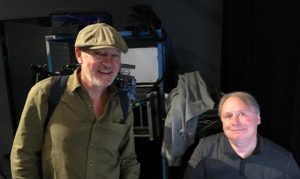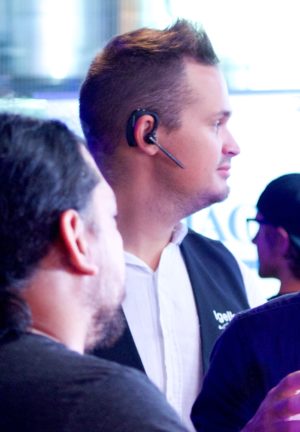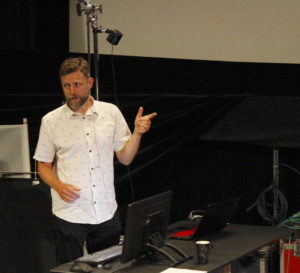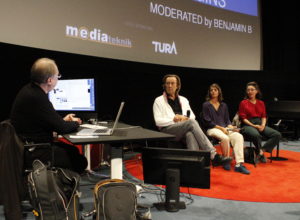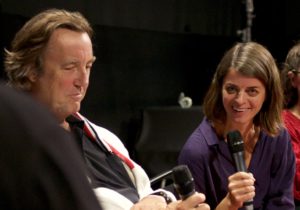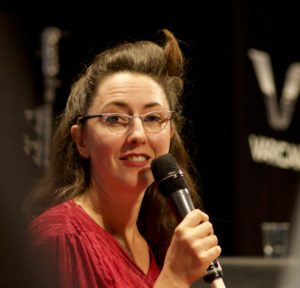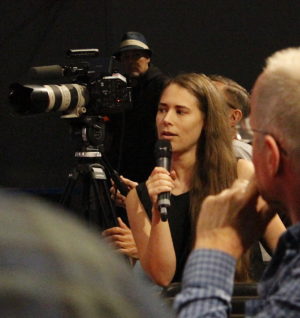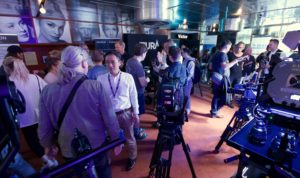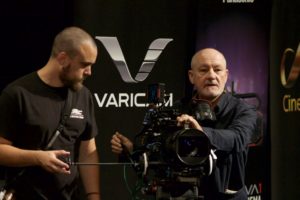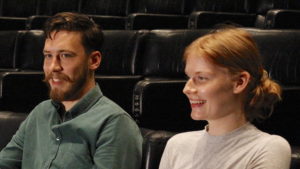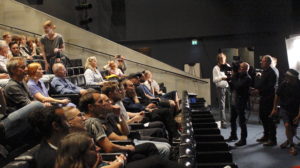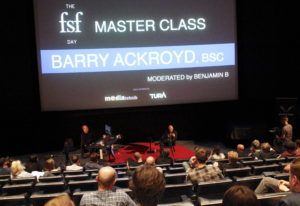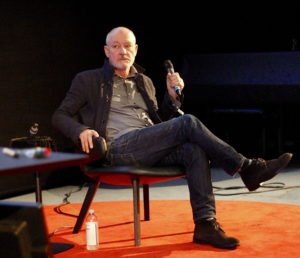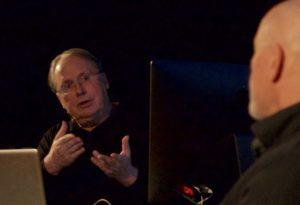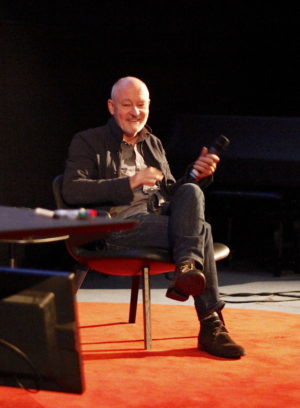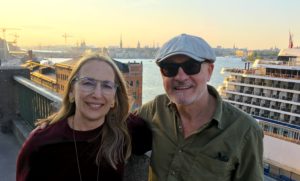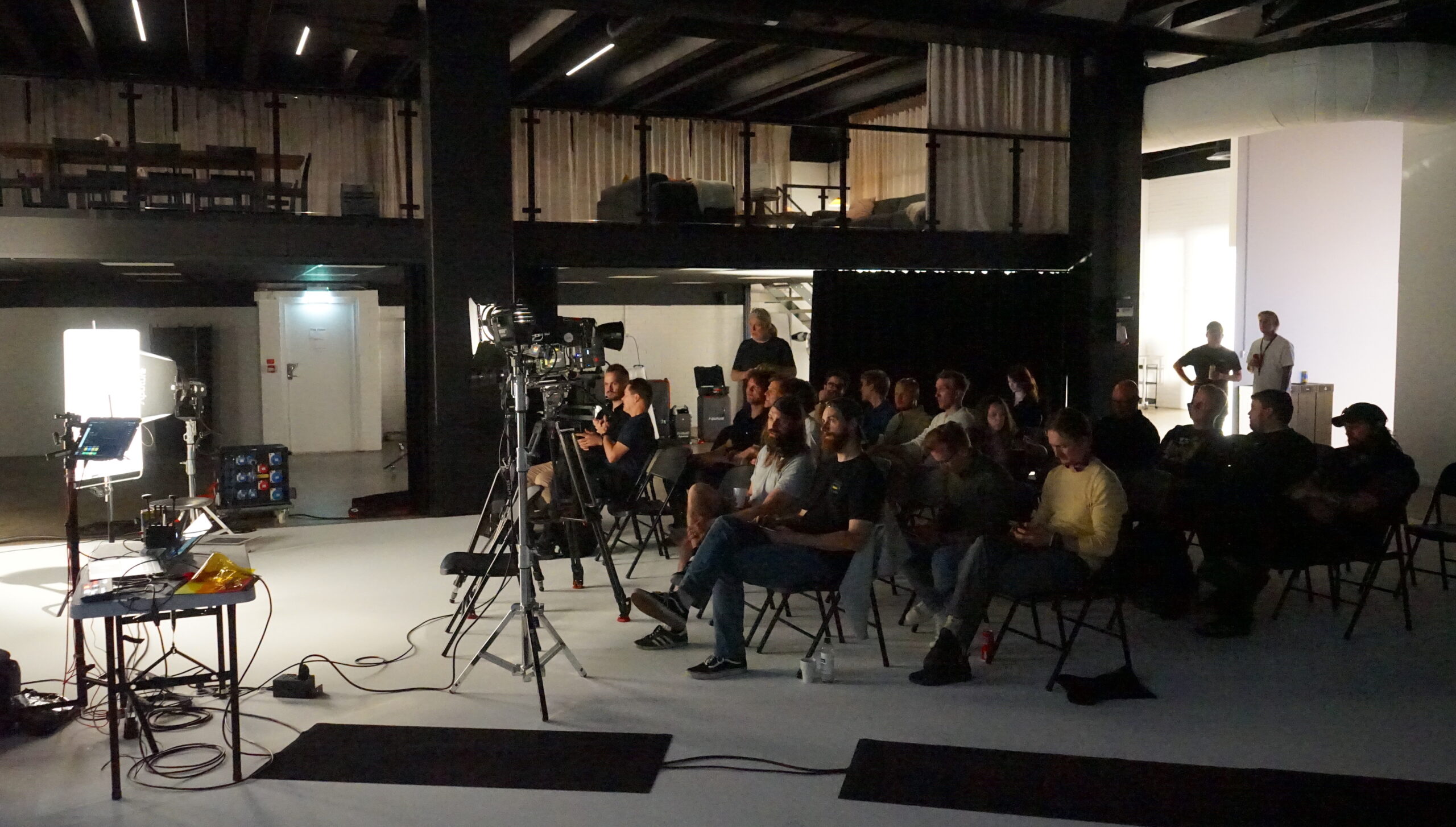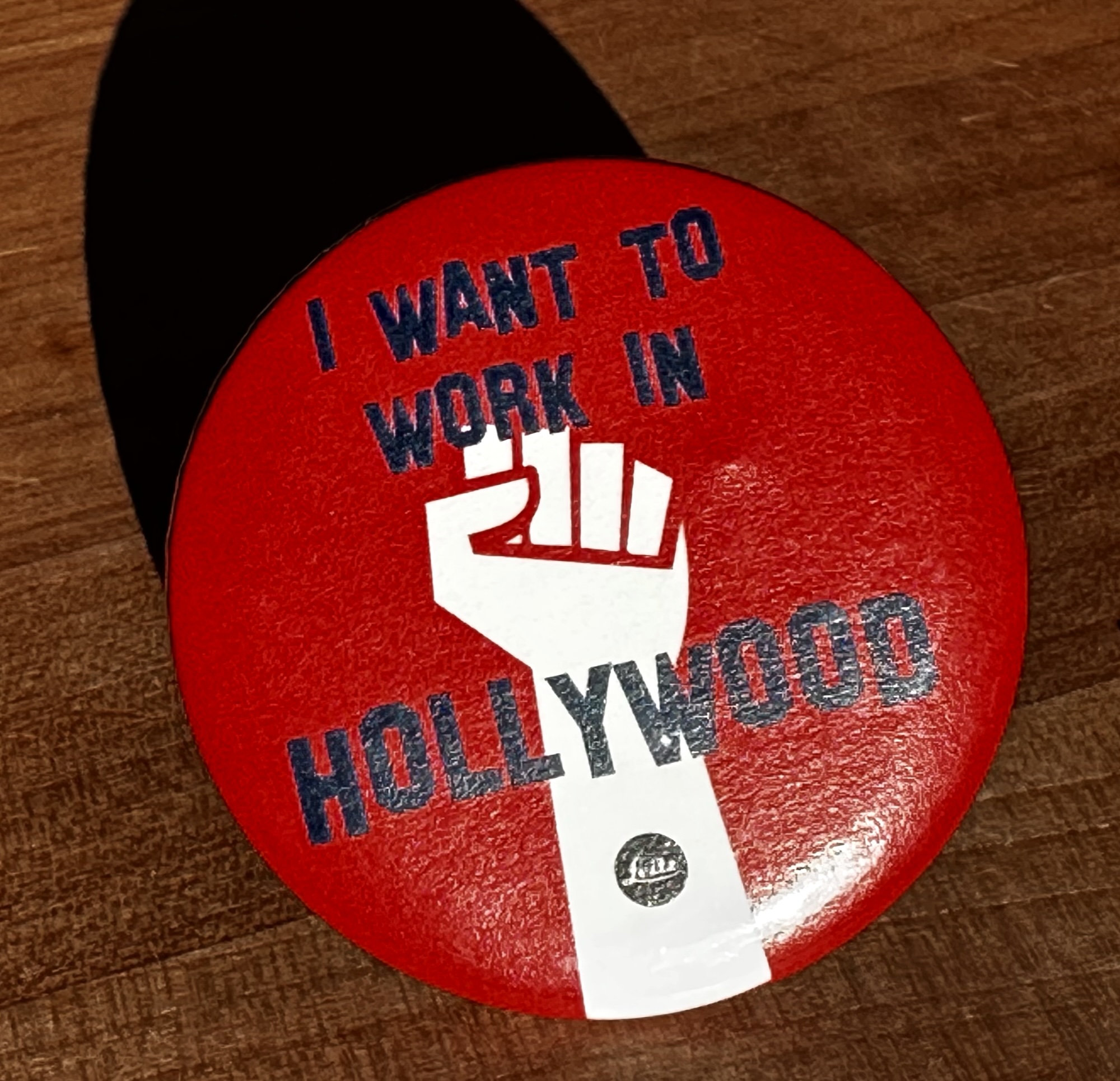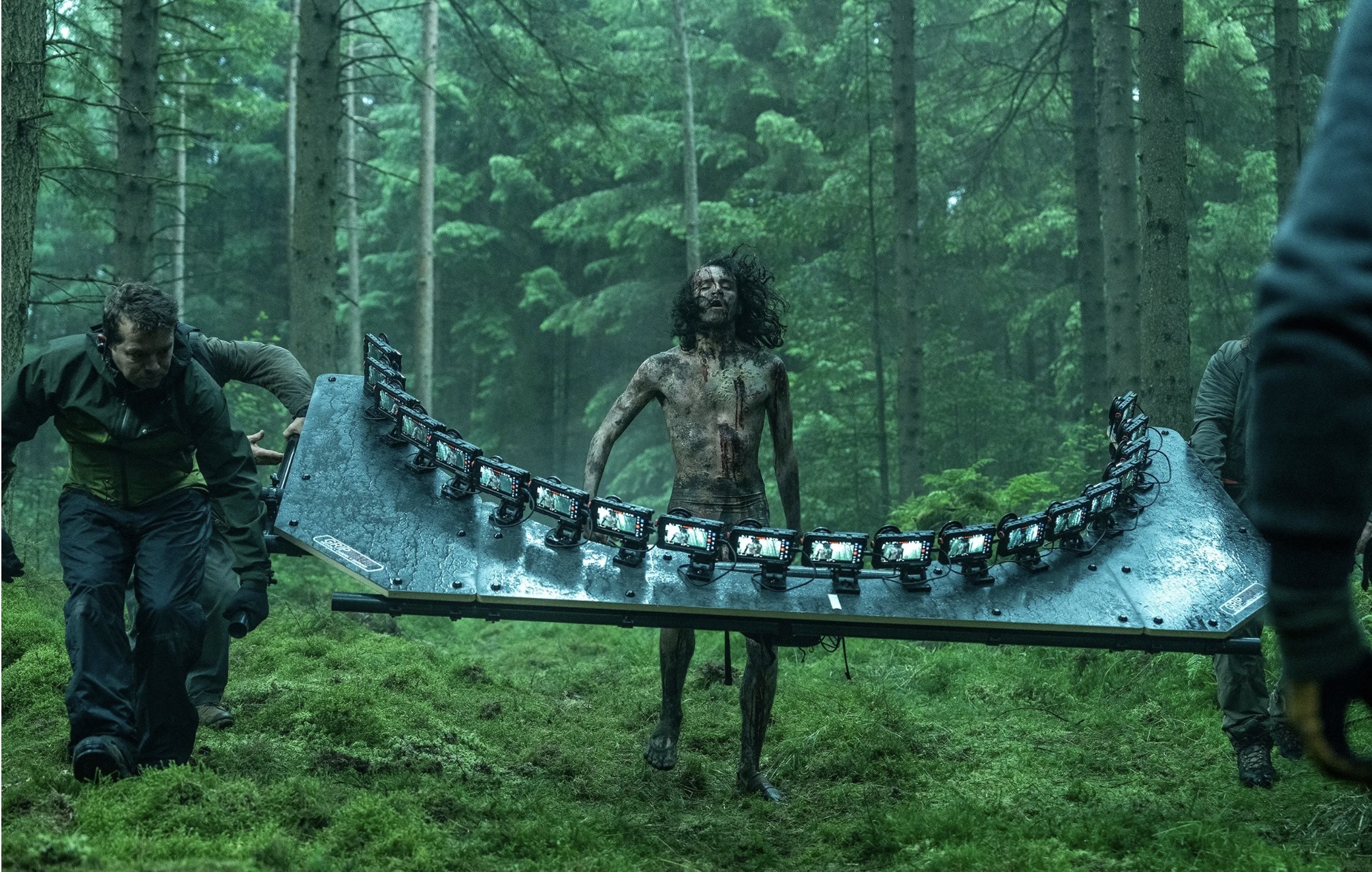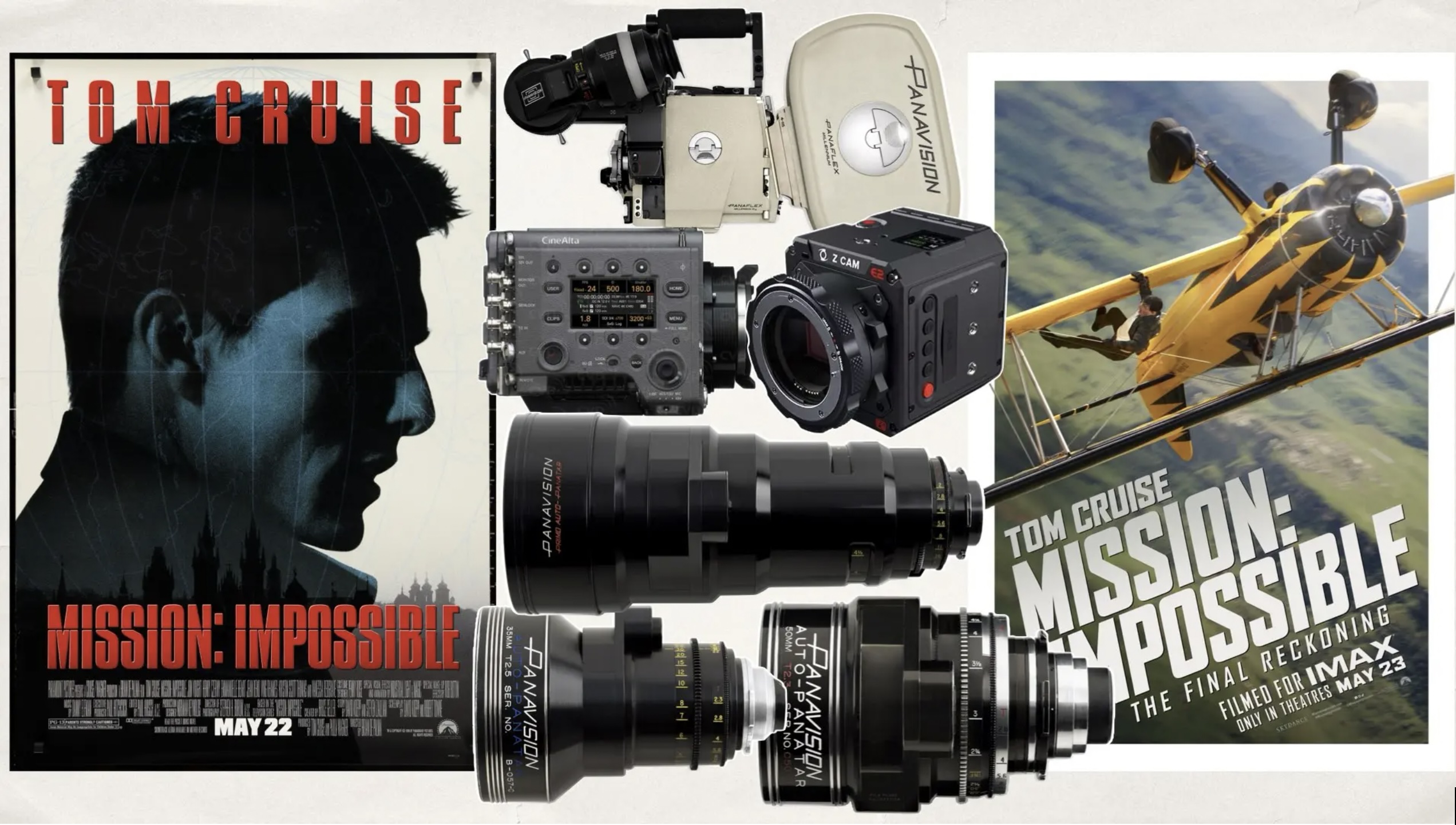The 2019 FSF Days
The 2019 FSF Days, held recently at the Swedish Film Institute (SFI) in Stockholm, happily proved to be a resounding success and drew a respectable crowd from the local filmmaking community, eager to be inspired by this cinematic event.
Held between Thursday 29th and Friday 30th of August, this year’s edition offered a significantly expanded programme compared to its 2018 predecessor. As usual, this event is arranged by The Swedish Society of Cinematographers (the FSF) with invaluable support from the SFI and our untiring sponsors.
This year’s Special Guest Star, appearing in no less than two major seminars, is distinguished British cinematographer Barry Ackroyd, BSC. And once again the internationally acclaimed film journalist Benjamin Bergery supervised the wall-to-wall programme. For those not familiar with Benjamin B, he is the author of the much appreciated book ”Reflections” in which he chronicles a number of cinematographers and their craft, and he also publishes his blog ”thefilmbook” on the ASC website.
The event opened on Thursday with an extensive program featuring exhibits by leading companies like Sony, ARRI, Fujifilm, etc, as well as two fascinating technical demonstrations. In the studio facilities of the SFI building –where among innumerable projects Ingmar Bergman’s magnum opus Fanny and Alexander (1982) was filmed- visitors were invited to check out a demonstration of a state-of-the-art mobile car rig for simulating shots of moving vehicles. Igelkott Studios, run by CEO Eric Hasso, is the company responsible for this rig, and in fact it stayed open to visitors all the way until late in the evening. Igelkott means ”hedgehog” in Swedish in case you wondered –and the company is so named in reference to owner Eric Hasso’s hairdo –I kid you not. 😉
The fact that this set up is mobile and possible to rig in any sufficiently large building makes it an ideal ”rain set” for a production working on location, provided the script contains car scenes of course. Additionally, the Igelkott team create their background plates with a VR camera, which speeds up that part of the process as well.
And the theme of Virtual Reality continued upstairs in the SFI Victor cinema (named after the great Swedish director Victor Sjöström) where VR specialist Simon Alexanderson gave a presentation on the use of VR in film production. He works for a small start-up company called Monocular which primarily focuses on pre-visualization. ”This is a planning tool, we’re not aiming for photorealism”, Simon declares, and goes on to demonstrate how their pre-viz tools can be applied to existing environments. ”Perhaps you know in advance you’ll be shooting someplace where time is critical and you won’t have time to look for the right camera angles once you’re on set”, he explains. ”Then finding the camera angles ahead of time in a pre-viz model can be a valuable advantage”.
And you don’t need to spend several weeks on 3D-modelling existing buildings from scratch either. Even though it sounds like science fiction, today with drones and lasers you can quickly scan large buildings into the computer and make a 3D model of them. Sometimes you can even use Google Earth to create a makeshift 3D model that will be good enough for pre-viz work.
Simon rounds off by explaining that many productions today do some postproduction work before going into principal photography, since backprojections are used increasingly in movies today –so those plates have to be created ahead of time, and Monocular’s tools are a convenient way of checking out how the finished results may turn out.
The Monocular seminar wrapped at 5 pm, and visitors now had an opportunity to either go out for a bite to eat or, if they hadn’t already done so, visit the Igelkott Studios car rig which was still open. Then at 7.30 pm, participants were invited to attend a screening of Kathryn Bigelow’s film Detroit (2017) in the SFI Mauritz cinema. This film dramatizes the riots in the US in 1967, in which close to 40 lives were lost, and in particular one deadly incident involving black youths and Detroit police. Barry Ackroyd opened the screening with a short Q&A during which he explained he feels it is an important film on a –sadly- still very current subject, and he feels it deserves to reach a broader audience. During it’s theatrical run it didn’t always find favour with the critics or connect well with audiences, in spite of the fact that it features some amazing performances from the main cast, in particular Will Poulter -of We’re the Millers (2013) fame- and John Bodeya.
From a technical standpoint, Bigelow wanted the film shot on super-16 but there were some serious challenges to that approach, as the story takes place at night in dimly lit locations. So Barry came up with an ingenious solution, using Arri Alexa Minis with Canon super-16 zooms. In combination with a very thorough colour grading process, one could have sworn the resulting footage was actually shot on film.
As the film is quite harrowing, there was an impromptu gathering of audience members for a while afterwards, clearly feeling a need to discuss the shared experience and its lingering impact with Barry. Though one might question the wisdom of staying up late like this the day before an important event, this was a valuable experience since we all got to know eachother better under relaxed circumstances.
And thus ended the first of the 2019 FSF Days.
By 8.30 am on Friday morning, a respectable crowd had already gathered in the tech exhibit just outside the Victor cinema, eager to get into the auditorium, and half an hour later they had gotten their wish and the show was off to a running start. The first entry of the day was simply called The FSF Day Seminar and consisted of a long conversation between Benjamin B and three distinguished Swedish cinematographers. They were Sophie Winqvist Loggins, Ragna Jorming and Ulf Brantås, and all are members of the FSF.
Two hours proved to be an almost criminally brief time for an in-depth conversation with three creatives as prolific as these, and time flew by as the audience was treated to an abundance of clips on the cinema screen.
Ulf Brantås opened with a few scenes from the HBO TV series Generation Kill (2008) which follows a group of U.S. Marines during the 2003 invasion of Iraq. ”I didn’t want to work on anything glorifying warfare,” Brantås clarifies, ”but happily this TV series was anything but pro-war.” The impressive war scenes clearly indicate that Generation Kill had a hefty budget, and an interesting discussion on the managment of time and money on a shoot ensues. ”Sometimes the second unit can have a bigger budget than the main unit,” Brantås offers, ”but in my experience you could always use more money than what you have.”
”Also,” he adds, ”we never do war movies in Sweden, and as a cinematographer it’s really good to have a broad palette, because you’re frequently asked ’have you done horror? War? Romance? etc.”
And Brantås’ palette is certainly broad enough as indicated by the films screened here, ranging from the stark realism of modern day warfare to chamber play drama. Benjamin screens a couple of clips from The Wife (2017) and Treasure Island (2012) featuring stellar acting from Glenn Close and Jonathan Pryce in the former, plus epic scope involving a real period sailing ship -and Eddie Izzard as Long John Silver- in the latter.
Glenn Close got an Oscar nomination and a Golden Globe for her work on The Wife, and Brantås’ cinematography deftly catches the actors’ performances in this piece. ”I always work with really long zoom lenses,” he explains, ”in order to be able to catch moments. I can zoom in and catch that moment when it happens.”
Brantås also has several valuable tips for his colleagues, not the least ”try to be like a fish in the sea -don’t fight the elements” and ”interesting always takes precedence over beauty.” When asked to exemplify the latter, Brantås offers, ”when someone says ’it’s a beautiful movie’ -I’m always skeptical. In my experience, a good movie will always have good cinematography, but not necessarily beautiful cinematography.”
Interestingly, Brantås also seems to hold a grudge against a certain group of cinema professionals, although his views on this seem to be somewhat tongue-in-cheek. ”In my experience I always have to explain even the most basic things to Line Producers, ” he offers -to the mirth of the audience.
Next up is Ragna Jorming who shows us a very eerie night interior scene from Camilla Strøm Henriksen’s film Phoenix (2018). It’s a ghost story type sequence told from the female lead’s perspective giving the audience a feeling of being halfway between dream and reality.
Ragna’s process involves reading the script several times and at the top of her list of ”Dos and Don’ts” we read ”don’t impose a form on the script, let the script tell you the form.” Another one of Ragna’s recipes for a succesful shoot reads ”respect everyone on set” to which Ulf Brantås quickly retorts: ”unless the Line Producer shows up”, evoking laughter from the audience.
Ragna has recently wrapped shooting on the film Quick (2019), which is the story of an authentic Swedish crime case concerning a man who for years was believed to be a dangerous serial killer, but who was finally exonerated from all accusations. Ragna shows her preparatory mood boards for the project and a few finished scenes from the film, which very ambitiously plays out on several levels chronologically. Ragna chose Cooke anamorphics to shoot the film and she’s very much infatuated with the anamorphic lenses, although she found the difficulty to focus at close range a minor drawback to the format.
The wide frame leads to an interesting discussion on formats. ”We’ve entered an era which I call the elastic frame,” Benjamin muses. ”There’s no real reason for 2,39 or 1,85 -you could have any aspect ratio you like today, so it’s historical reasons really that lock us into classical aspect ratios.”
An impressive sequence from Aniara (2019), a low budget sci-fi film based on famous Swedish author Harry Martinsson’s poem, introduces our third panelist here today: Sophie Winqvist Loggins. As the story here takes place in an unspecified future, the budget constraints led Sophie to look for futuristic environments that could be accessed cheaply, finding them in shopping malls, hotels and even onboard a local Stockholm ferry!
Sophie asserts that her strategy centers on first reading the script, alone and uninterrupted. She writes down the first impressions she gets, and then begins to ”collect DNA for the movie” as she puts it, and then proceeds to toss those bits of DNA on the director ”to see what sticks.”
Sophie has been in frequent collaborations with director Ninja Thyberg, who is actually in the audience here and explains that she has been intereseted in gender issues and The Male Gaze for a long time, and that her motivation for making her upcoming feature debut Jessica, set for a 2020 release and shot by Sophie Winqvist Loggins, was an opportunity to reverse that perspective, to create The Female Gaze by deliberately pointing the camera in the other direction.
Before the clip from Jessica is screened, Benjamin cautions the audience that what we are about to witness takes place in the L.A. adult film industry.
”Being French,” Benjamin jokes, ”for me, this is of course not a problem.”
The film follows a Swedish 20-year-old girl who wants to become the next big porn star in the L.A. adult entertainment industry. It is definitely poised to create big waves when it hits the theaters –it’s a given that it’ll create a lot of debate and controversy.
And on that note the FSF Day Seminar featuring Swedish cinematographers ends, and Benjamin and his panelists are met with well-deserved applause.
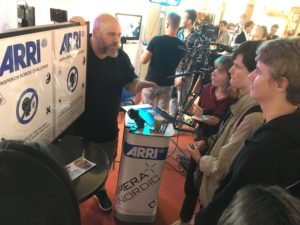
Steve Calavitis in the Camera Nordic booth explains their film competition ”Unspoken Nordic Challenge”.
The audience now get a chance to stretch their legs in the tech exhibit outside the cinema, and there’s a really friendly and humorous atmosphere as everyone mingles among the amazing products on display.
This particular break is sponsored by Camera Nordic, who, in addition to demonstrating their products to curious visitors, also take this opportunity to launch their short film competition ”Unspoken Nordic Challenge”. This is a national Swedish film competition which they have created in collaboration with ARRI Cine Technik GmbH, and under the slogan ”Let the image do the talking” they invite cinematographers, directors, film school students, in short any member of the Swedish filmmaking community who accepts their challenge, to participate in this competition. Details about the ”Unspoken Nordic Challenge” can be found on the Camera Nordic website (https://cameranordic.com/blog/2019/09/The-Unspoken-Nordic-Challenge).
Then it’s time for the most famous guest of the FSF Day, the Academy Award nominee and BAFTA winner for Best Cinematography: Barry Ackroyd, BSC. In the first of two events with Barry, called theCamera Operating Workshop, he demonstrates to the audience how he likes to work with the camera and the actors.You might say he ”reveals his secrets”, but Barry is a great believer in spreading knowledge and doesn’t mind sharing his tricks of the trade, so the audience is in for a highly educational treat.
In Barry’s own words, he’s often asked by directors to ”do that thing you do.” ”The director wants to capture something in the way I work visually,” he explains, ”it’s sort of become my signature.”
In front of the audience seated in the Victor cinema, and just below the screen, Barry and his assistants have placed a short tripod with a slider and a Varicam 35 with an Angénieux 24-290 mm T2.8 zoom, one of Barry’s favourites. He feels it ”sees things the way I see them.” Next to this camera, Barry has another Varicam, also equipped with an Angénieux zoom, only this is the shorter 28-76 mm version. This camera is configurated for handheld work, whichis one of the signature cornerstones of Barry ’s visual style, and he likes to operate himself.
To make this workshop come to life, Barry and Benjamin are working with two highly talented actors: Linda Öberg and Simon Aghed Luterkort, and together they’ve worked out a scene in which the actors are having a bit of an argument while walking up the stadium seating of the cinema. Barry constantly catches their performance alternately with the long zoom lens on the slider and with the handheld Varicam. Throughout the workshop Roy Rossovich, FSF, acts as 1st AC to Barry.
All throughout members of the audience keep asking interesting questions to Barry who answers them diligently. We learn for instance that Barry isn’t a great fan of remote focus when handholdning, he prefers the focus puller to be close to the camera working directly with the follow-focus knob. With remote follow-focus gear, your freedom of movement becomes limited, because you may want to do a quick whip-pan to follow the action –and wind up with your focus puller in full view!
As he frequently works with multiple cameras, Barry has also become quite skilled over the years at keeping the other cameras out of his shots! He’ll whip-pan past them so quickly that they never register. His other operators are not always as lucky though, they’ll pan too slowly and occasionally wind up with a fellow team member in the frame.
In fact, watching Barry in action here and seeing his resulting footage on the big screen during the workshop, you immediately recognize his visual style, his framings, the way he zooms in or out – and it really is like an author’s recognizeable handwriting!
The operating workshop ends with thundering applause and we then depart for a somewhat late lunch break, before the afternoon continues with the main event of the FSF Days, a Masterclass with Barry Ackroyd, BSC, moderated by Benjamin Bergery. And Benjamin opens the Masterclass with an analytical comparison between Barry’s visual style –which we have just witnessed firsthand in the previous workshop- and early 20th century Cubist painters like Picasso and Braque. They were influenced by the cinema of their time to experiment with multiple geometrical perspectives in their paintings, much the way that Barry does in his camerawork. Benjamin also suggests that Barry’s style can be labeled temporally Cubist in that it cuts up time and shows events from a multitude of viewpoints, both visually and temporally. Having attended art school in his youth, Barry gracefully accepts these comparisons between his work and that of Picasso and Braque. Barry is also a big fan of shooting on film, and all titles screened during this Master Class were originated on either 16 or 35mm film.
Hailing from Manchester, England, Barry explains that both his political convictions and his fascination with cinema came from watching films while growing up. Ken Loach’s Kes (1969) in particular struck a deep chord in him when, in his youth, he first saw it. ”I was obviously better off than the leading character in Kes, but the whole school situation in that film was not that dissimilar from my own childhood,” he offers.
Barry describes what an eye-opener it was to him when he first realised that these films, which he so admired, were actually made by ordinary people. One of Ackroyd’s biggest early breaks was when he came in contact with Chris Menges, ASC BSC, who was the cinematographer on Kes as well as a number of seminal titles such as The Mission (1986) and The Killing Fields (1984).
Barry considers Menges to be his cinematographic mentor, and it was through him Barry was introduced to Ken Loach. When years later Ken Loach asked Barry to shoot a feature for him, Ackroyd didn’t need many seconds to make up his mind about accepting the offer.
To represent Barry’s long collaboration with Ken Loach, Benjamin has chosen a few scenes from Land and Freedom (1995) which is a story about the Spanish civil war. It was extremely well received by critics, and The Observer called it ”one of the finest films of the decade.”
”It was the fourth film I shot for Ken,” Ackroyd remembers, ”and the first one on 35 mm. I was 40 years old. Ken didn’t want dolly or tripod or zoom, and the lighting could never interfere with the actors. I learned to smuggle lights into the scenes, to make them part of the scenery. It was also the first war film I did. As you’ll see there were many more after that.
I worked with Ken for over 20 years shooting altogether 12 features for him,” Ackroyd muses. ”I knew I had it in me to do something different from that, so I eventually felt a need to work for other directors on other kinds of material.”
Barry credits his wife Ann, who is in the audience here, with holding the family together through all the rollercoaster years of filmmaking. Both their daughter and son are in the business, producing commercials in Spain and working as a successful DoP in his father’s footsteps, respectively.
And on a BBC production in 2002, Barry definitely got what he wished for in terms of different material. The aptly titled Out of Control, a violent tragedy about young offenders in London directed by Dominic Savage, is really Barry’s breakout film.
”It’s a little like the French film La Haine (1995),” Barry elaborates, ”and Dominic Savage was one of the first directors to say to me ’that’s great, give me more of that!’”
Which once again leads us to ”that thing Barry does” –Benjamin suggests that Ackroyd’s tremendously personal visual style is a kind of performance.
”Yes, there is absolutely an improvisational aspect to it,” Barry concedes, ” if it were music it would be jazz, I suppose. From the first Ken Loach film to the latest film I’ve shot, I hope there is a signature to the cinematography, that’s what I always strive for anyway. I try to find my own voice in someone else’s story. I try to translate the passion of the actors and the story through the camera. I feel the camera should always be appropriate to what the story is. If the story is static, then the camera should be static. The rhythm must be right.”
And the film was very important for Barry’s career, because soon afterwards he received a phone call from director Paul Greengrass who wanted Barry to be the cinematographer on his upcoming 9/11-drama United 93 (2006). Barry had shot two decades worth of work for Ken Loach and thought that perhaps that was what had piqued Greengrass’ interest, but no, it was the Dominic Savage film. ”Paul is a very British filmmaker,” Ackroyd notes, ”he is from the British tradition of journalistic documentary filmmaking.” Having just directed his first Jason Bourne thriller which had been very successful, Greengrass was on a roll. Benjamin feels that United 93, which earned Greengrass an Academy Award nomination for Best Director, is a masterpiece.
”For the actaul hijacking scenes I used several cameras with 4 minute film loads,” Barry recalls, ”so one camera was always running. I’d hidden magazines all along the airplane aisle so we could constantly reload and make sure at least one camera was always running. That way we could cover a 40-50 minute ”take”, the actors didn’t have to start and stop the whole time, they could just act the whole way through the sequence and it obviously allowed them more freedom than if they’d had to do it in sections. We did three such ”takes” on the same day and everyone was physically and emotionally exhausted afterwards.”
The film was screened for an audience in which some of the relatives of the victims were present and it of course became an intensly emotional experience, but the realtives gave Barry and the filmmakers the greatest praise possible, by saying that they felt the film was appropriate and dignified.
To date, Barry and Paul Greengrass have made four films together, and he feels that European filmmakers tend to be more open to the complexities of the situations they portray, for instance, the perpetrators aren’t simply faceless villians in their view. ”There’s something about how we as Europeans portray a situation,” Ackroyd offers. ”For instance, ’Captain Phillips’ is about an American captain, but you do feel the Somali situation as well.”
The Master Class flies by as if the hours were minutes, and there’s only enough time left now to round it off with two enormously adrenaline-charged titles: Kathryn Bigelow’s The Hurt Locker (2008) (for which Ackroyd won a BAFTA and was nominated for an Academy Award) and Paul Greengrass’ Captain Phillips (2013).
Barry relates how United 93 led to a phone call from director Kathryn Bigelow who wanted him to shoot her gut-wrenching, uncompromising war drama The Hurt Locker.
”They had decided to shoot it in Jordan,” he recalls, ”because they wanted to work as close to the actual location as possible and they obviously couldn’t go to Baghdad. Amazing stuff has been shot in Jordan, Lawrence of Arabia for one.”
The film was nominated for no less than nine Academy Awards and won six, including for Best Picture of the year, and it also made Bigelow the first female director to be honoured with a Best Director award. Ackroyd is understandably very proud of the film and his cinematography received widespread acclaim.
Benjamin shows us two clips from The Hurt Locker, showcasing the second cornerstone to Barry’s visual style: multiple cameras. An interesting discussion follows in which Barry acknowledges the fact that you need to label the cameras A, B & C if you’re going to use multiple cameras on a project, simply to keep track of all the parts, but he doesn’t subscribe to the theory that the A camera is the one that’s supposed to get all the great shots. He encourages every operator to get the best shots possible all the time.
Ackroyd was honoured by the ASC for his work on The Hurt Locker and recounts how the ASC members were surprised to hear it was shot on super-16: ”they were convinced it was shot on 35 mm,” he smiles. He feels that Shooting super-16 is a brilliant idea. ”It’s my favourite format in many ways,” he clarifies, ”the cameras are light, you can carry them easily, there are great lenses for the format, not least the Canon zooms. In short, you have that all-seeing eye that you can carry in your hand.”
There is now only time for one final amazing piece of film, this one from Paul Greengrass’ Captain Phillips (2013). Barry explains to us that ”Tom Hanks here is giving a performance like never before in his career, because he had no idea what would happen to him when we shot the scene. His character has been through Hell and has now come back to the world of the living.”
We are shown the clip and as it fades away from the screen and the house lights come up again, that also concludes the FSF Day Master Class: Barry and Benjamin are met with well-deserved thundering applause.
The FSF wish to thank all whose efforts made this day a reality. Obviuosly we are greatly indebted to Barry and Ann Ackroyd without whom this event wouldn’t have been possible, to Benjamin B for masterminding the seminars, to Ulf, Sophie and Ragna for sharing their experiences and to Linda Öberg and Simon Aghed Luterkort for generously gracing our Operating Workshop with their considerable acting talent.
Behind the scenes Olof Johnson, Alex Lindén, Michael Kaare Petersen, Roy Rossovich, Marcus C.F. Tinnerholm, Roland Sterner, Nille Leander and Markus A. Ljungberg (all members of the FSF) put in a solid effort, and from the Swedish Film Institute Jerry Axelsson, Janine Andersson and Thomas Berg gave invaluable support.
Additional ”unsung heroes” behind the scenes were Tom Brennan, CSI and Victor Johnson.
Thank you also to Twentyfourseven AB for lending a hand when we most needed it!
And of course the FSF Days would not have been possible without the support from our sponsors: Camera Nordic, Igelkott Studios, Fujifilm, and RED Rental by MAAN, with particularly heroic efforts by Anders Johansson from Mediateknik AB, Daniel Thisell from Ljud & Bildmedia and Peter Kroopp from Panasonic.
Perhaps there could be no more fitting way of rounding off this article, than the words with which Barry Ackroyd closed his Masterclass.
”There has to be a real consequence to what the characters do in the films I choose to work on, that’s the most important aspect to me. I think cinematography is without question an art form, and Real Cinema is about humanity and life and it tells you something.
The world needs better cultural input, and next year there will be more films made –and you guys in the audience will be making them -and I look forward to seeing them!”
Lars Pettersson
